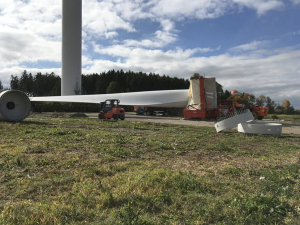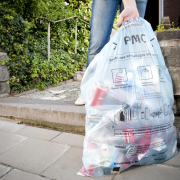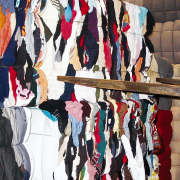Waiting to Be Recovered: Wind Turbine Rotor Blades
At a campaign rally in late February 2020 in Colorado Springs, former President Donald Trump declared that “after a period of time, wind turbines get tired, they get old, they get rusty, and a lot of guys say hey, their useful life is gone, let‘s get the hell out of here”. However, the reality is slightly different. Apart from the fact, that wind power plants are not abandoned due to rust, but mainly due to local and state laws or other stipulations: Especially turbine blades are corrosion-resistant, contain valuable raw materials and are waiting to be recovered.
According to WEA, the World Wind Energy Association, in 2017 almost one million wind power units were installed. The worldwide ranking is led by China with 752,000 installed units, followed by USA with 161,000 units and the United Kingdom with nearly 29,000. The rest of the world shows a total of 69,000 units with Germany (17,000), Canada (11,500) and Japan (11,500) at the front. A study on wind turbine blade waste in 2050, conducted at the University of Cambridge Institute for Manufacturing, came to the estimation of 43.4 million tons of resulting blade waste by weight in 2050. For the best case – caused by low manufacturing in-process waste rate, low new installed capacity and long blade lifespan – it could result in 21.4 million tons. In favor of high waste volumes including highest waste rates, high new installed capacity and short lifespan, the waste could reach 69.4 million tons. The research indicated that China will be possessing 40 percent of the waste, Europe 25 percent, the United States 19 percent and the rest of the world 16 percent.
A mix-up of material
The challenge in treating rotor blade waste lies in their material composition. Generally, rotor blades are made of fiber-reinforced polymer composites. The reinforcing fiber consists of glass, carbon, aramide or basalt; hybrids with a combination of glass and carbon fiber exist as well. They are agglutinated with a matrix of polymers, especially thermosetting plastics like epoxide resins, polyester, vinylester, polyurethane or thermoplastics; usually 60 to 70 percent fiber is combined with 30 to 40 percent resin. The sandwich core material is delivered by balsa wood, difficult to raise and consequently often substituted by polyvinylchloride in the form of PVC foam or PET (Polyethylene Terephthalate). The blade is coated by PE (Polyethylene) or PUR (Polyurethane). And finally, the blades contain metallic leads of copper or aluminum wiring as well as steel bolts for lightning conduction. This mix-up of substances complicates further treatment.
Not popular: thermal utilization
In 2011, National Wind Watch, Inc. published an article stating that “because the wind-turbine industry is relatively young, there is only a limited amount of practical experience on the removal”. So “the most common route is incineration”. But, at that time, even the burning in combined heat and power plants was evaluated critically: The remaining ash – 60 percent after incineration – might have been pollutant and was either landfilled or recycled as a secondary construction material. And it could not be excluded that the emissions contained hazardous flue gasses and the glass fiber spares caused problems at dust filters. According to an article published in 2020 by Danmarks Tekniske Universitet based near Copenhagen, incinerating for energy recovery was called a solution currently used in Denmark. But it has its drawbacks including not combustible glass fiber, disturbance of the gas cleaning system, and large amounts of fly ashes that need to be disposed of or used. However, even now, the thermal utilization of rotor blades is not popular: The material can only be treated in manageable quantities, which may cause problems like blockading of the incineration plants and cannot find sufficient customers. In late December 2019, Remondis’ press spokesman Michael Schneider made evident that even special engineering facilities refuse to accept that sort of waste and that in Germany just one single plant treated such material. He declared that “everything, except for rotor blades, is very well recyclable”; in his opinion, “rotor blades of wind energy plants are special refuse”.
900+ blades landfilled
Another method of treating abandoned wind turbines could be dumping or – more sanitary – landfilling. In Europe, this is increasingly difficult thanks to toughening EU waste rules. As rotor blades contain around 30 percent of organic substances like resins and sandwich materials, they must not be landfilled. In June 2005, Germany, for example, introduced a landfill disposal ban on glass fiber reinforced plastics; Austria, Finland and the Netherlands forbid composites from being landfilled. Unlike in Europe, landfilling of turbine blades might become popular in the United States. In September 2019, three windfarms in Wyoming partnered with the Casper Regional Landfill. Their goal was to dispose of more than 900 blades, made from fiberglass and judged un-recyclable. “Casper is the only landfill in the state that has the certification to show that it is environmentally responsible”, Casper Solid Waste Manager, Cynthia Langston, gave account. There is not only the ecological aspect that leads the landfill operators to that decision: The profit for them totaled 675,485 US-Dollar, the regional online-magazine Wyoming News Now reported. However, the American Wind Energy Association assesses the landfilling as the safest and cheapest method. Greg Alvarez, the association‘s spokesman, is sure that “all of the blade waste we may be producing over the next 30 years is equal to .015 percent of all the new municipal waste that goes into landfills in one year”. Although the transport of up to 82-meter large units is an enormous cost variable in treating, this model could perhaps be used as an example throughout Northern America. The Electric Power Research Institute shares this belief. In May 2020, EPRI Senior Technical Executive Ken Ladwig assumed: “By 2050, the industry could send approximately four million tons of wind turbine blades to U.S. landfills.”
Recycling
If refurbishment, reuse or repurposing of blades are not possible, recycling and recovery appear to be the next options. According to a new technical report on wind turbine blade recycling, released by the Electric Power Research Institute (EPRI) in April 2020, there are three vital recycling methods: pyrolysis, use in cement kilns and re-grind or re-use respectively. Pyrolysis describes a process used to recover glass or carbon fibers, char, and/or gases for energy. After re-sizing the blades, they are decomposed in conventional heating ovens in an inert atmosphere at 450 – 700°C. The treatment in cement kilns comprises three steps: grinding limestone to get a mixture, the heating of this mixture to up to 1000°C or even more, and finally grinding the resultant clinker material into cement. In Germany, the cement kiln process is already being used commercially for glass fiber wind turbine blade disposal, while in the U.S. no commercial facility yet exists for this purpose. Finally, re-grind and re-use mean mechanical processing of the material to various sizes or different forms like chunks, needles or powder by cutting, shredding, crushing or milling. Following the EPRI paper, the list of recycling and recovery techniques could be completed by chemical solvolysis, vacuum cracking, wet chemical breakdown, fluidized bed pyrolysis (i.e. gasification), electrochemical treatment, high-voltage fragmentation, microwave pyrolysis, and ultra-high temperature gasification.
Companies established
In 2012, a scientific article on the recycling of composite materials balanced: “Various technologies, mostly focusing on reinforcement fibers and yet to be commercialized, have been developed: mechanical recycling, thermal recycling, and chemical recycling. However, lack of adequate markets, high recycling cost, and lower quality of the recyclates are the major commercialization barriers.” Meanwhile not only the question of how to slice the rotor blades is off the table: Cutting by waterjet, diamond wire, hydraulic scissors or a demolition claw is well known, and Veolia developed a special rotor blade saw used to cut up the blades into small pieces on-site. But in the last years, several companies have been established in the field too.
In Germany, for example, the so-called composite recycling developed in 2011 offers a 100 percent recycling quota for glass fibers, as it allows the efficient energetic and substantial recovery of the
material. Bremen based GreenTec Award excelled neocomp GmbH shredders the blades and separates metal containing parts. Half of the resulting granulate – fibers and resins – is thermally utilized by established processes and delivers electricity for the cement industry. The residual glass ash can be used as a substitute for silicate or raw sand. The German Wind Energy Association (BWE) estimates that in this way, the use of 1,000 tons of fiberglass reinforced plastic can save about 450 tons of coal, 200 tons of chalk and 200 tons of sand. In February 2016, an online magazine wrote that “Germany maintains the world’s only industrial-scale factory for reprocessing wind turbine blades”.
R3Fiber and ReFiber
In Spain in 2017, EDP Renewables and Thermal Recycling of Composites joined for a pilot project to develop the R3Fiber technology. The technology allows a thermochemical transformation converting the resins of combustible gases and liquid fuels into reusable glass or carbon fibers. Mass, energy and materials are said to be reused without producing additional waste. The resulting fiberglass or carbon fiber is similar to the composites used to manufacture the original blades.
R3Fiber must not be mixed up with ReFiber, a technique practiced by the Danish Refiber Aps company. The shredded material is fed continuously into an oven with a temperature of 500°C, pyrolyzing plastic into synthetic gas. A second oven cleans the glass fibers, metals and dust are removed, glass fibers and polypropylene fibers are then mixed. Finally, another oven melts the plastic fibers and connects them with the glass fibers to a stable insulation slab.
CHZ Technologies’ Thermolyzer technology is a controlled pyrolysis processing, recycles all liquids, tars and oils from composite materials and converts them into clean synthetic gases. The company is establishing several processing facilities in the U.S., intending to treat 100 tons per day of turbine blades combined with other materials like poles or railroad ties. According to EPRI, the procedure converts organic polymer materials into clean fuel gas and recoverable char with reinforced carbon and glass fiber for reuse in another polymer product.
In the discussion
The techniques just mentioned are based more or less on thermolysis or thermal decomposition. However, other methods are subjects to scientific discussions too. Researchers at the Fraunhofer Institute for Wood Research, for instance, developed a technique to extract balsa wood from the rotor blades. This tropical wood is much too valuable to be burned, physicist Peter Meinlschmidt was convinced. A master thesis, submitted to the University of Utah in 2016, investigated whether recycling of wind turbine blade composite material was suitable as an aggregate in concrete. And the Journal of Cleaner Production published a scientific article about the effectiveness of wind turbine blades waste combined with sewage sludge. The result: Co-pyrolysis can enhance the sewage sludge sequestrated carbon quantity through the introduction of other carbon-containing precursors.
Re-grinding with potential
Global Fiberglass Solutions delivered a different approach. It was said to be the first U.S.-based company to commercially recycle wind turbine blades into viable products. GFS used a mechanical breakdown process to reduce the size of the blades by grinding the material, removing metal bolts and fasteners, separating the shredded pieces by gravity and receiving particles between fibrous and powder consistency. GFS’ Chief Executive Officer Karl Englund anticipated the utilization of 99.9 percent of every blade and the handling of an amount of about 6,000 to 7,000 blades per year. In January 2019, the company began the commercial production of its recycled EcoPoly brand pellets, made out of thermoplastic fiberglass and suitable for injection molding and extrusion manufacturing processes. The pressed pellets and fiberboards were expected to get a new task in flooring, the building of walls or other outdoor applications. In an interview, GFS’s chief technology officer Karl Englund estimated that the method could cost the wind farm owner less than solid waste disposal. But in February 2020, Ken Becker, executive director of an economic development agency, acknowledged that the company was “struggling financially”. It seems that replenishment was lacking. Meanwhile, the GFS homepage presents only its recycling services for thermoset composite fiberglass materials; the subpages for wind turbine blade recycling are inactivated.
Techno-economic differences
In its comprehensive report on wind turbine blade recycling, the Electric Power Research Institute provided a “techno-economic” ranking of the three most applied recycling methods. The comparison shows that mechanical processing faces “steep challenges”, lacks attractive end products and misses economic rewards. Cement kilns are seen as more sustainable but seem twice as expensive as solid waste disposal. Pyrolysis for the recovery of carbon fiber turns out to be more attractive than the recycling of glass fiber. But it is valid for all options that economic profit can only be seen if the sales of recycled materials plus the value of energy recovery are higher than the sum of amortized capital costs and operating costs. If the result is negative and a manageable loss, the wind farm owner has to pay for his end-of-live material. If the loss is expensive, he will (and currently does) choose to dispose of his material as solid waste.
Grinding and co-processing staying behind
In their study on “Accelerating Wind Turbine Blade Circularity”, released in May 2020, WindEurope, Cefic (European Chemical Industry Council) and EUCIA (Association of the European Composites Industry) started another calculation comparing six different composite recycling technologies:
- Gasification in a fluidized bed for the recovery of fibers and fillers as well as energy in the form of heat and gas
- Solvolysis to extract mineral compound and fibers
- High voltage pulse fragmentation for matrix pieces and fibers
- Pyrolysis to recover fibers, fillers and char as well as hydrocarbon products
- Mechanical grinding of fiber-reinforced plastic resulting in a matrix and fiber-rich powder and waste material
- Co-processing in cement kiln reactors for the production of heat and clinker cement.
In the technologies number one to four, the potential material value of carbon fiber surpasses the processing costs. The highest earnings, but also the highest expenses, were calculated for the solvolysis. The relative highest profit turned out to be delivered by pyrolysis, especially as this treatment draws profit from the potential material value of glass fiber. Mechanical grinding and co-processing stay far behind since the value of glass fiber material exceeds the process costs. However, the margins only reach a quarter of the profits of gasification and pulse fragmentation, a fifth of pyrolysis and a sixth of solvolysis.
Waste-neutral blades coming up?
According to the WindEurope, Cefic and EUCIA study, the main technology for recycling composite waste today is through cement co-processing. Various technologies already exist or are developed, and an increasing number of companies offer composite recycling services; these solutions are not yet widely available and cost-competitive. Regarding the output, composite recycling at the moment is a cross-sector challenge and a challenge for the wind industry competing against sectors like building and construction, electrical and electronics, transportation, marine, production waste, aeronautics, consumer and tanks and pipes. That is why the paper warns: “Actually, the (low) volumes of composite wind blade waste make it challenging to build a recycling business based mainly on this waste stream. All the composite-using sectors must work together to find cost-effective solutions and value chains for the combined volume of composite waste.” So, the designing of fully recyclable or reusable wind turbines is desirable, but literally still “in the air”.
But there is hope. In January 2020, Vestas Wind Systems, – in its own words – Denmark-based “world’s largest supplier of wind energy” by turnover, announced to produce zero-waste wind turbines by 2040. They are already focusing on improving the recyclability of all wind turbine blades since “incremental targets will be introduced to increase the recyclability rate of blades from 44 percent today to 50 percent by 2025, and 55 percent by 2030”.
(Published in GLOBAL RECYCLING Magazine 1/2021, Page 36, Photo: Steffen Hoeck / Pixabay)










